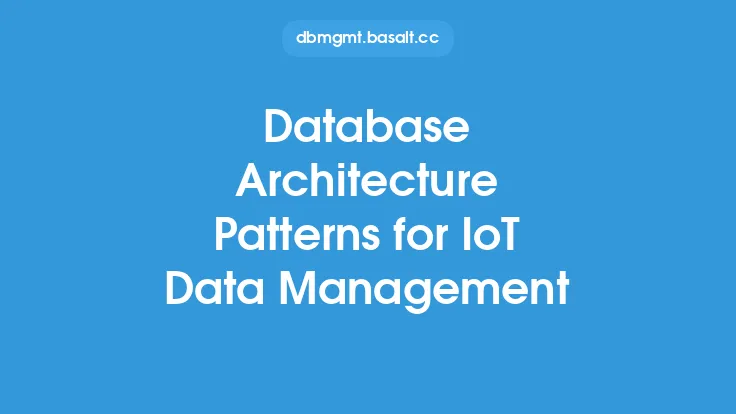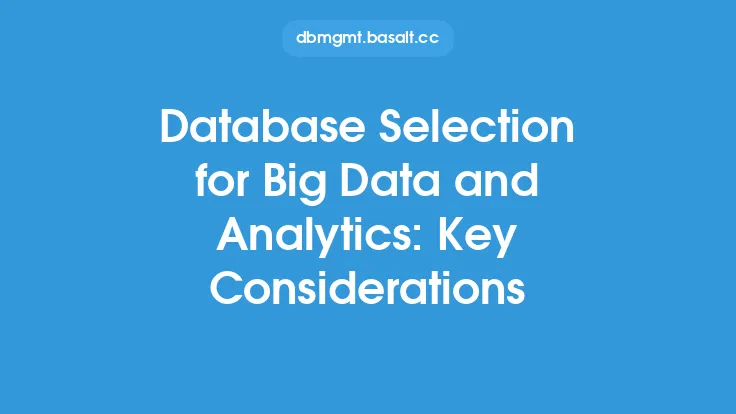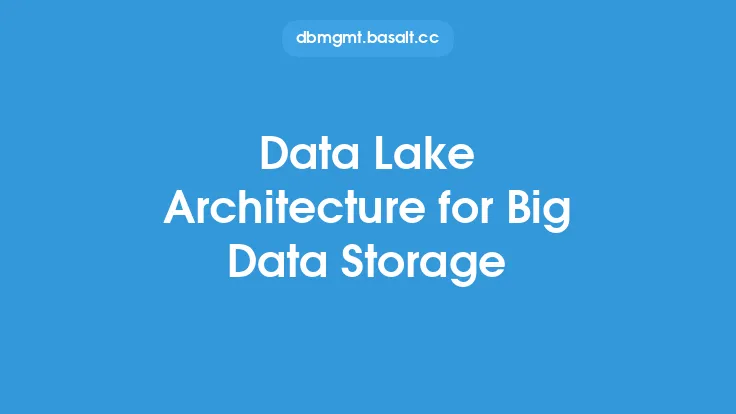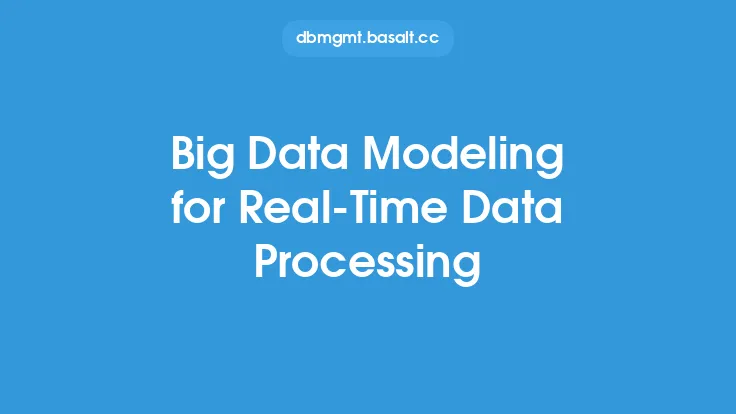The increasing volume, variety, and velocity of big data have led to a significant shift in the way databases are designed and implemented. Traditional database architectures are often unable to handle the scale and complexity of big data, resulting in performance issues, data losses, and increased costs. As a result, organizations are turning to specialized database architectures that can efficiently store, process, and analyze large amounts of data. In this article, we will explore the key components and considerations of database architecture for big data.
Introduction to Big Data
Big data refers to the vast amounts of structured, semi-structured, and unstructured data that organizations generate and collect every day. This data can come from various sources, including social media, sensors, mobile devices, and applications. The characteristics of big data are often described using the 5 V's: volume, velocity, variety, veracity, and value. The volume of big data is enormous, with organizations generating terabytes of data every day. The velocity of big data is high, with data being generated in real-time. The variety of big data is also significant, with data coming in different formats, such as text, images, and videos. The veracity of big data is a major concern, as the quality and accuracy of the data can vary greatly. Finally, the value of big data lies in its ability to provide insights and inform business decisions.
Key Components of Big Data Architecture
A big data architecture typically consists of several key components, including data ingestion, data storage, data processing, and data analytics. Data ingestion refers to the process of collecting and transporting data from various sources to a central location. Data storage refers to the repository where the data is stored, which can be a distributed file system, a NoSQL database, or a cloud-based storage service. Data processing refers to the act of transforming and analyzing the data, which can be done using batch processing, stream processing, or interactive analytics. Data analytics refers to the process of extracting insights and meaningful patterns from the data, which can be done using statistical models, machine learning algorithms, or data visualization tools.
Distributed File Systems
Distributed file systems are a crucial component of big data architecture, as they provide a scalable and fault-tolerant way to store large amounts of data. A distributed file system is a file system that is spread across multiple machines, allowing data to be stored and retrieved in parallel. The most popular distributed file system for big data is Hadoop Distributed File System (HDFS), which is designed to handle large amounts of data and provide high-throughput access to data. Other popular distributed file systems include Amazon S3, Google Cloud Storage, and Microsoft Azure Blob Storage.
NoSQL Databases
NoSQL databases are another key component of big data architecture, as they provide a flexible and scalable way to store and retrieve data. NoSQL databases are designed to handle large amounts of unstructured and semi-structured data, and they often use a variety of data models, such as key-value, document, and graph. The most popular NoSQL databases for big data include Apache Cassandra, Apache HBase, and MongoDB. NoSQL databases are often used for real-time web applications, social media, and mobile apps, where data is constantly being generated and updated.
Data Processing Frameworks
Data processing frameworks are used to process and analyze big data, and they provide a scalable and efficient way to handle large amounts of data. The most popular data processing framework for big data is Apache Spark, which provides a unified engine for batch and stream processing. Other popular data processing frameworks include Apache Hadoop MapReduce, Apache Flink, and Apache Beam. Data processing frameworks are often used for data integration, data transformation, and data analytics, and they provide a flexible and scalable way to handle large amounts of data.
Data Analytics Tools
Data analytics tools are used to extract insights and meaningful patterns from big data, and they provide a variety of techniques, such as statistical models, machine learning algorithms, and data visualization tools. The most popular data analytics tools for big data include Apache Hive, Apache Pig, and Apache Mahout. Data analytics tools are often used for business intelligence, predictive analytics, and data science, and they provide a flexible and scalable way to handle large amounts of data.
Considerations for Big Data Architecture
When designing a big data architecture, there are several considerations that must be taken into account. Scalability is a major concern, as big data architectures must be able to handle large amounts of data and scale horizontally to meet increasing demands. Performance is also a major concern, as big data architectures must be able to process and analyze data in real-time. Security is another major concern, as big data architectures must be able to protect sensitive data and prevent unauthorized access. Finally, cost is a major concern, as big data architectures can be expensive to implement and maintain.
Best Practices for Big Data Architecture
There are several best practices that can be followed when designing a big data architecture. First, it is essential to define clear goals and objectives for the big data architecture, and to identify the key use cases and requirements. Second, it is essential to choose the right technologies and tools for the big data architecture, and to consider factors such as scalability, performance, and security. Third, it is essential to design a flexible and scalable architecture that can handle large amounts of data and scale horizontally to meet increasing demands. Fourth, it is essential to implement robust security measures to protect sensitive data and prevent unauthorized access. Finally, it is essential to monitor and optimize the big data architecture regularly, and to make adjustments as needed to ensure optimal performance and scalability.
Conclusion
In conclusion, big data architecture is a complex and challenging field that requires careful consideration of several key components and factors. By understanding the characteristics of big data, the key components of big data architecture, and the considerations and best practices for designing a big data architecture, organizations can create a scalable, flexible, and secure architecture that meets their needs and provides valuable insights and business value. Whether you are a data architect, a data engineer, or a business analyst, understanding big data architecture is essential for success in today's data-driven world.





